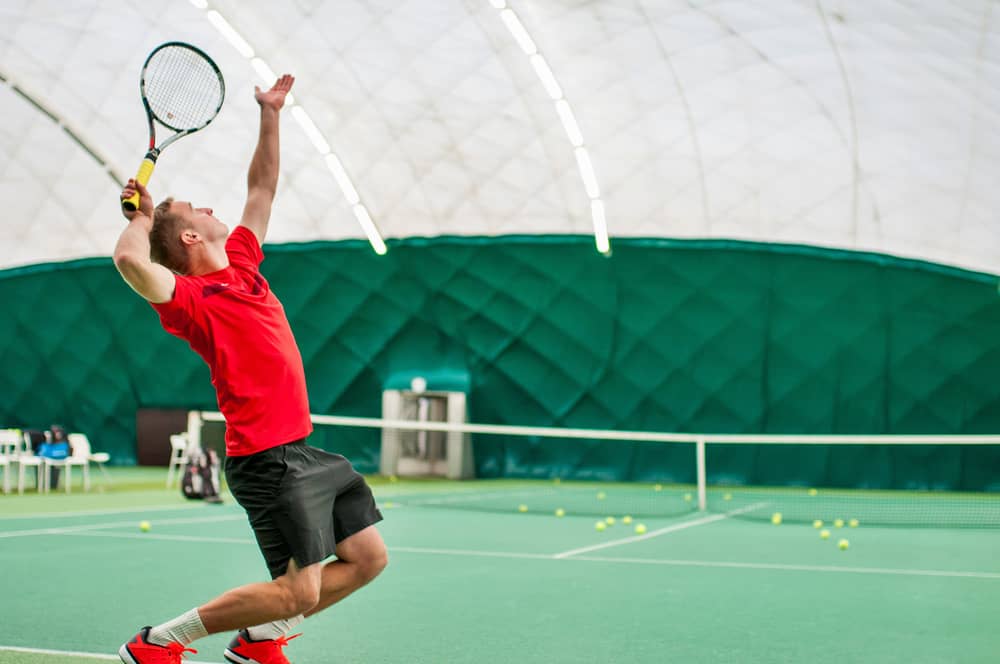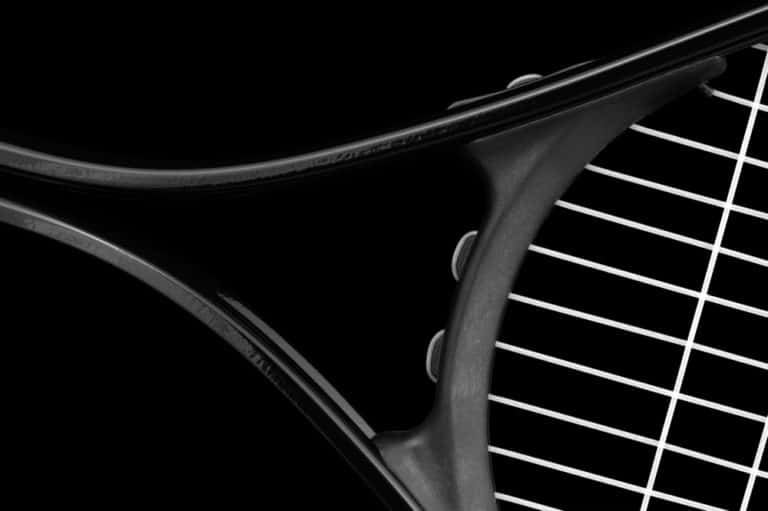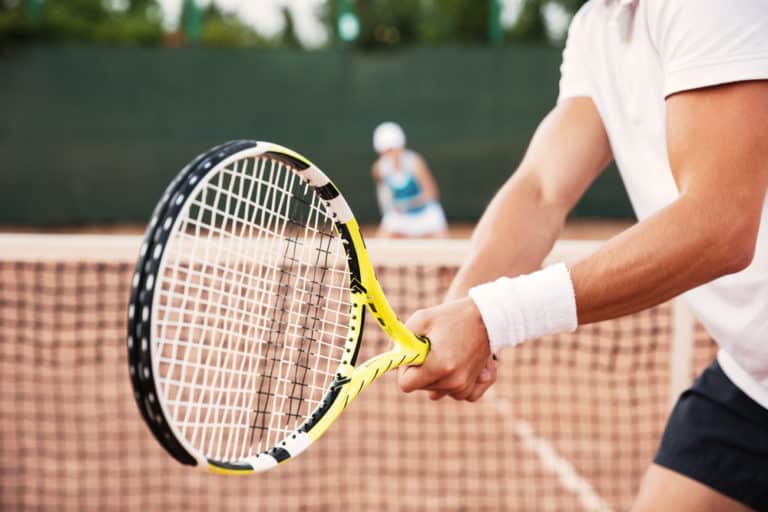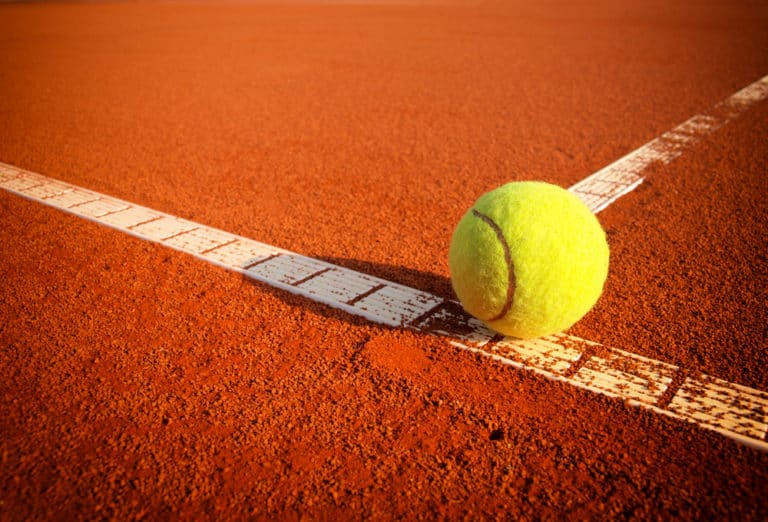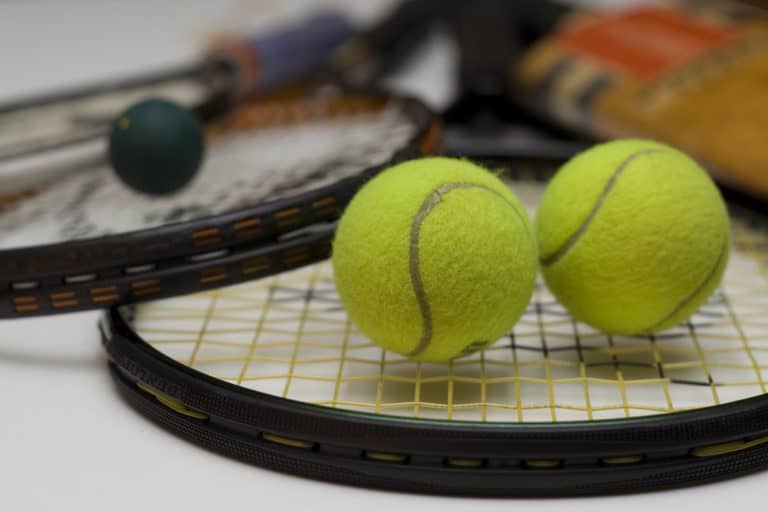How Many Let Serves Are Allowed In Tennis?
A serve is one of the hardest things to master in tennis, especially when you are still a novice. There are times when even professional players do not get a serve right from the start and will have to serve again. This is called a let serve (or, mistakenly, a “net serve”), and it is one tennis rule that often leads people to ask, how many let serves are allowed in tennis? Is there even a limit?
You are allowed an unlimited number of let serves in tennis. If a let is called, you are allowed to serve again. It is re-served until the ball no longer touches the net. There have been cases where professional players served four lets in a row, and each had to be re-served to start the point.
You may have heard an umpire call a “let, first serve” while you were a live spectator or watching tennis on the television and noticed that the server serves again, and sometimes again, until they get the serve in play. This is because a let serve literally means that you must re-play the serve to start the point. Let’s look more closely at the let serve in tennis and what it really means.
What Is A Let Serve?
A service let, or let serve, is when you serve the ball, and it touches or makes contact with the net, landing in the cross-court service box, but doesn’t touch the net post or any other object like a strap or band. When this happens, play stops immediately, and the server has another turn to serve, or even another, and yet another (you get the idea).
A let serve can also happen when the ball, after touching the net or other object (like a strap or band), touches the receiver (or even the receiver’s partner, if you’re playing doubles), or anything they carry or wear, without touching the ground. It could also be called a let serve if you serve the ball when the receiver is not ready yet.
In any situation where a let is served, the service does not count, and in all of these instances, the server must simply serve again with no limit to the number of let serves. Thankfully professional players don’t serve lets often; otherwise, tennis matches would go on for much longer than they currently do.
The only occasion when the ball is allowed to touch the net is with a return shot, which will be considered good and not a fault, though a point may be lost in the process.
How Can You Tell If You Served A Let?
In professional tours, like The Grand Slam Tournaments and other highly-rated tournaments, you will have an umpire specifically dedicated to the job of calling a let serve. Apart from the referee, there are other measures in place to recognize if a ball is touching the net while serving or not.
The Measures To Tell If It’s A Let
There are two sensors placed at each end of the net, and these sensors are connected with a cord that leads to a box. Its official name is TRINITY, and this net cord machine is not available for commercial sale. The device is patented and is only available to be rented out.
Even the Association of Tennis Professionals (ATP), World Tennis Association (WTA), and ITF (International Tennis Federation) only have contracts to lease the machine from its owners; they don’t own the devices themselves.
The net cord machine (TRINITY) was invented by a German Engineer named Dietmar Brauer. It works using two sensors that will emit a signal to the control box if they detect any vibrations. Even if the ball has just nicked the net, it will detect any small vibrations, which will indicate to the umpire that there was a let serve.
TRINITY is also designed to vibrate with beeps, and the beeps will indicate if a serve is a let or a fault, depending on where the ball touches the net and where it lands after touching. If the ball lands within the opponent’s service box, then it is considered a let.
Can You Return A Let Serve?
You shouldn’t return a let serve. It is not allowed. The server’s ball must hit the ground of the court, and the ball must land inside the correct service box for it to be a good serve, and only then are you allowed to return the serve.
When Is A Served Ball A Fault?
We have already established that a let serve is when you serve a ball and the ball comes in contact with the net before bouncing into the correct service box and that a let serve is allowed to be served again until it is a good serve. But there is a difference between a let serve and a serve fault.
There are two faults that can occur while you serve the ball. It is considered a fault:
- When the ball touches the net but doesn’t land inside the correct service box, or
- When a served ball hits the post.
No-Let Serve Rule
Professional tournaments don’t have a no-let serve rule since pro tournaments are played strictly by the rules set out by all relevant organizations. Tournaments have everything in place to tell if you played a ‘let’ serve so that you can simply re-serve and carry on with the match.
But what about other, less formal matches? Obviously, if you are just playing with friends, you may choose to adapt the rules to suit you. More official matches that are not professional enough to justify a TRINITY device have some other options, though.
It is possible to assign a third-party person to notice if the ball touches the net so that they can call a let serve. Or you can decide that both players should be able to call a let serve if they notice it. You can even assign a ‘no-let’ serve rule in a casual match of tennis, where no lets will be called. This will lead to a much quicker tennis match, especially if amateurs play the game.
What Are The Rules For Serving?
First of all, in tennis, the rules state that a serve always starts a point. You do, however, get two chances for the ball to get into play with your first serve. A first serve always begins with the server behind the court’s baseline, and the server will also be between the center mark of the court and the right sideline.
The ball is always hit diagonally inside that service box and over the net to the other side (if it touches the net, it is a let serve). The ball should also be on the opposite center mark from which the server is serving. However, when you hear the call “Let, First Serve,” you will still keep your first serve and be allowed to serve again.
A server shouldn’t step on or over the baseline before the ball is served. Once you’ve hit the ball, you are allowed to step on or over the baseline.
With the first point of the game, it is always a rule that the first serve must go over the net and land correctly in the correct service box, which is in the receiver’s proper service court. However, if the first serve doesn’t go into the right service box, then it is called a fault. You do, however, have a second serve if a fault occurs.
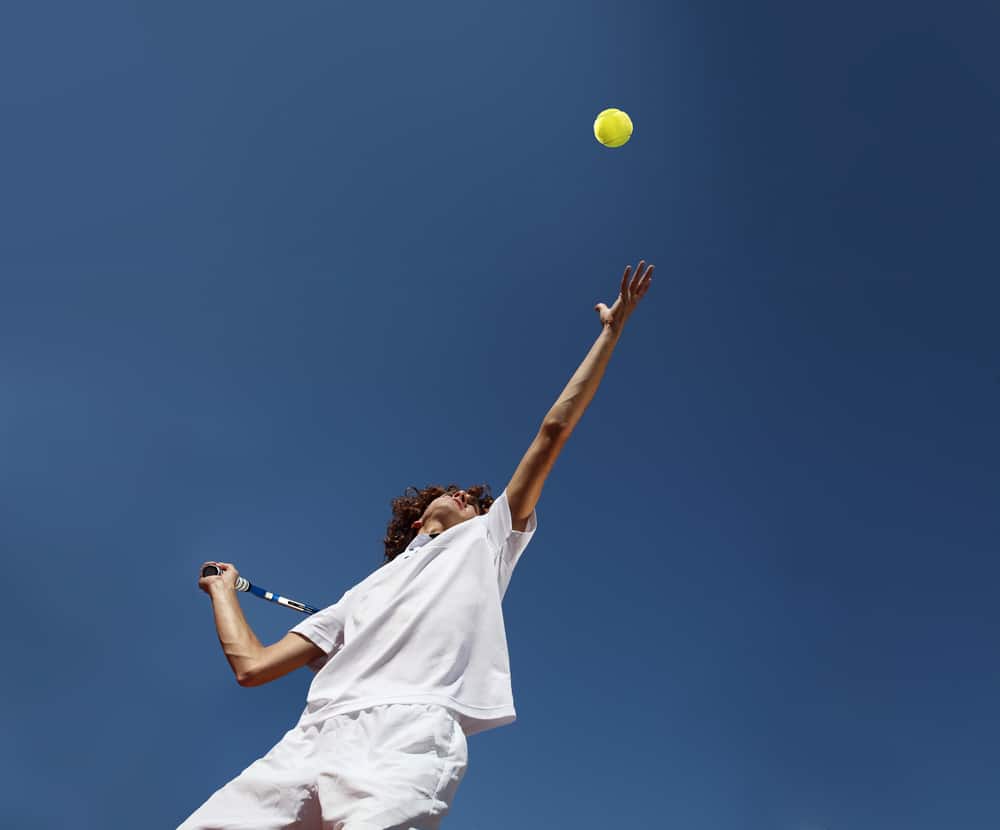
Professional Players Hitting Let Serves
A let serve is not something to be ashamed about. There are examples online where even professional or world champion players served lets during their professional careers, and it is evident that even they get frustrated when hitting let serves. But luckily, you get multiple chances to get the ball into play with a first serve or a second serve in case there was a fault in the first serve.
Serena Williams
In 2013 Serena Williams beat Ayumi Morita in Miami, but during that tennis match, Serena had a moment where she had four service lets in a row. This did not deter her from taking the win against a very skilled player anyway.
Di Wu
Di Wu would have the same fate as Serena William with four consecutive let serves in a row at the Challenger tournament, played in Anning, China, in 2017.
Matteo Berrettini
Another rare occurrence in professional tennis was recorded in 2021 when Matteo Berrettini also had four let serves in a row in Cincinnati, USA.
The History Of Tennis And Let Serves
The history of tennis can be dated back to the 12th Century when the French played a handball game called “Jeu de Paume,” which simply translates to “game of the palm.” In the 16th and 18th centuries, Jeu de Paume became very popular among the royal families and noblemen. Soon after this, the game became what is now known as “real tennis.”
Real Tennis And Let Serve Rules
The rules of real tennis state that a serve is good if it is not a fault, and once a serve is a fault, then the ball is dead and can not be returned. There was a “no-let” rule in real tennis. These original rules state the following with regards to serving:
- It will be a fault when the server fails to have contact with the floor at the time when the server strikes the ball or the server touches the second galley line or any other part of the court between the second galley and the net.
In real tennis, the only time that a let was allowed was when the receiver of the ball was not ready for a service and did not make any attempt to play the ball. In that case, and only then, a let serve was allowed.
So in the original form of tennis, there was no let serve, and the let was written into the rules at a later stage to make provision for serves that went wrong.
The History Of Tennis As We Know It Today
The All England Croquet Club was established in 1870 at Wimbledon in the district of London. At this time, tennis was still an indoor game played by royals, noblemen, and wealthy benefactors.
In 1873, Major Walter Wingfield wrote a book about a type of real tennis that could be played outdoors on a lawn. This game was first called ‘” phairistike,” which means “playing ball.” This is really the point where you can start to see the first signs of tennis as we know it today.
“Sphairistike” featured two net posts, a net, rackets, and Indian rubber balls. Wingfield’s book is called “The Game of Sphairistike or Lawn Tennis,” and facsimiles of it can still be found today, though not easily or cheaply. However, no mention is made of a let serve in this original 1874 rulebook.
Lawn Tennis
In 1921, a book was published entitled “The Art Of Lawn Tennis.” This is the first written mention of a let serve in tennis. In this book, a let is a serve that touches the net in its flight yet falls in court or any illegal or irregular point that does not count. However, the book never mentions that a let serve may be re-served if this occurs.
Obstacles
The mystery of when let serves were allowed to be re-served is solved when we consider another rule contained in the two original tennis rule books: the obstacle rule.
An obstacle could be called if a player served the ball, but the ball was obstructed by an obstacle like a cow that wandered onto the court. In this case, the ball was allowed to be re-served until an obstacle-free serve could be delivered.
Since more modern tennis was played on dedicated courts where obstacles were unlikely to be encountered, this rule was removed, but the let serve rule was updated with the same re-serve provision.
Let Serves In Similar Sports
Since tennis is such an old game, many variations have evolved from it over the years, and they all have their own takes on the let serve.
Badminton
In badminton, there are a few factors that can occur for a let to be called, and there is a let serve rule in badminton. However, you do not have an unlimited serve spree in badminton if your shuttle gets caught in the net after a serve.
- A ‘let’ shall be called during service if both players faulted at the same time.
- If a server serves and the opponent is not ready to receive the shuttle, then it is a let.
- A let can also occur after a service court error. When a let occurs in this instance, the play since the last service shall not count, and the server shall serve again.
- A let serve shall not be re-played if the shuttle is caught in the net.
Table Tennis
Just as with tennis, there is no limit to the number of lets you have on a serve. If you serve a fault, however, you will lose the point. As with tennis, you have two serves if a fault occurs before you lose a point.
Pickleball
Pickleball used to have a let serve, but the rules changed in 2021. The rules now state that if the pickleball touches the net, you must play the ball if it lands in the service court just as you would with any other serve. If the ball first strikes the net and lands in the non-volley zone, it will count as a fault.
Conclusion
In tennis, a serve can be a weapon to your advantage, or it could be a disadvantage. For you to use your serve as an asset rather than a liability, you must master your serve and have patience. Even though tennis is very competitive, patience is the key to a good serve. Good practice will help you to avoid lets and make you a master at the game.
References
- https://www.youtube.com/watch?v=gZY06NpaG-4
- https://www.youtube.com/watch?v=6w3dD7UUJac
- https://www.youtube.com/watch?v=VeqHgVEmckE
- https://www.britannica.com/sports/tennis
- https://www.masterclass.com/articles/guide-to-tennis-serves#quiz-0
- https://www.quora.com/Why-do-they-say-let-in-tennis
- https://www.quora.com/Why-in-tennis-when-the-tennis-ball-hits-the-net-is-it-called-let
- https://www.quora.com/In-tennis-matches-these-days-there-is-a-beep-sound-when-the-service-ball-touches-the-net-What-is-the-technology-behind-that-That-sound-does-not-come-after-service-so-the-umpire-switches-it-off-or-something
- https://www.reddit.com/r/Pickleball/comments/kdtr3h/2021_new_rules_must_play_lets_dropserves_legal/
- https://www.quora.com/What-is-a-let-in-badminton?q=badminton%20let%20serve
- https://www.quora.com/search?q=let%20serve%20in%20table%20tennis
- https://www.quora.com/Who-invented-tennis
- https://tennismash.com/2016/02/23/the-origins-of-the-most-common-words-in-tennis/

